Austria’s WIFO – Tourism Analysis: Positive Mood For The Coming Summer

For the coming summer season of 2024, higher numbers of overnight stays are expected in domestic tourism. The number of overnight stays is expected to reach a new high in the summer half of 2024 and be just above the record level of the previous year. In any case, various surveys among holiday guests show a high willingness to travel, but at the same time the current economic situation in Austria and also in Germany, Austria's most important source market, could continue to dampen guests' willingness to spend.
The real sales development is therefore unlikely to be able to keep pace with the dynamics of arrivals and overnight stays. As in the recent past, guests will pursue different savings strategies (cheaper accommodation and destinations, shorter stays, less consumption during their vacation), which was already apparent in the last summer and winter seasons.
Quality instead of quantity in tourism
In view of high inflation and price increases, it is more important than ever for the Austrian tourism industry to focus on quality instead of quantity. A wide range of offerings, including both higher-priced and lower-priced holiday alternatives, will be crucial. Local experiences, cultural events and regional culinary offerings can help appeal to different groups of guests while strengthening the local economy.
Review of the past winter season
Tourism demand in Austria again reached peak levels in the first five months of the winter season (November 2023 to March 2024) with over 17.6 million arrivals and around 64.5 million overnight stays. These figures almost correspond to the highs of the comparable period in 2018/19. Compared to the previous year, arrivals increased by 8.5% and overnight stays by 5.6%. The international segment was significantly more dynamic with an increase of 10.1% in arrivals and 6.0% in overnight stays, while domestic tourism increased by 4.5% and 4.1% respectively.
In the current analysis period, the previous high of 2018/19 was missed by just 0.2% with a good 64.5 million overnight stays. The number of guest arrivals was already slightly above the pre-pandemic mark at over 17.6 million.
Despite these positive developments, sharply increased prices and guests' increased tendency to save dampened real revenues. Tourism revenues were therefore unable to keep pace with demand. The warm spring temperatures and the resulting shortening of the ski season also played their part in this.
Calendar effects and their impact
However, special calendar effects, such as the leap day in February 2024 and the early Easter date in March 2024, distort the comparison with previous winter seasons. If you adjust for these effects, the increases are significantly lower: the adjusted values for overnight stays in February and March 2024 result in an increase of only 2.3% and a decrease of 12.1%, respectively. Overall demand from November 2023 to March 2024 would therefore stagnate almost at the level of 2022/23.
Even when adjusted for the calendar, sales growth is significantly lower: instead of nominally 10.2%, sales would only increase by 4.8%, and in real terms instead of +2.7% it would even rise by -2.5%.
Since the pre-crisis period of 2018/19, the Austrian tourism industry's income has increased by almost a fifth, but adjusted for rising prices there has been a loss of 11.7%. The growth discrepancy between overnight stays and price-adjusted sales even increased in the current analysis period.
There were clear differences in sales development (without adjusting for calendar effects) between the federal states: Burgenland and Vienna recorded the highest sales increases, while Salzburg and Lower Austria had the weakest balance sheets.
Mood in the tourism industry
Against the backdrop of this very subdued real sales development, which, in conjunction with rising input and wage costs, is also depressing companies' profits, the economic sentiment in the tourism industry has recently deteriorated. According to the WIFO economic survey assessing the current situation, the balance of positive and negative responses in April was negative for the first time since February 2022. Expectations for the future development of the industry are more optimistic, but remain rather cautious.













